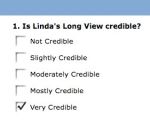January 3, 2011
Unstuck
Back in August my blogging waned and by October it was gone. No real reason except that I was stuck.
Although usually quite reselient, I got stuck when I lost my illustion of victory against osteoporosis. What did I have to say after I had already declared victory in Moved the Needle by achieving one full standard deviation (from -2.6 to -1.6) of improvement after my first year and then regressing a half a standard deviation (-1.6 to -2.1)?
My battle with osteoporosis had helped me to create this blog, but my too early victory declaration reduced my commitment to my long-view premise and credibility. It was just easy to get involved in other important pursuits…
Yet, I have continued to feel the pull of the long-view, so I am declaring myself unstuck.
My long-view advice to self:
- Stay confident when faced with a setback.
- Persist when investing in the future (the long-view).
For the record, I regressed a half a standard deviation after one year of drug holiday (Boniva) but fully compliant load-bearing exercise (increased mineralization) and calcium supplements (increased mineral availability).
In late summer, I will know whether I can achieve -1.1 in 2011 with the assistance of drug therapy (Boniva).
Drip, Drip, Drip!
March 16, 2010
Workarounds Don’t
I was reminded recently of one of my long view axioms – workarounds don’t work (for long).
Workarounds have a finite duration for which they will enable correction/detection of an existing problem. This is because they require extra effort for what is usually an infrequent problem. Thus, as humans, we tend to forget, begin to believe it is unnecessary (it doesn’t really matter), or it was simply too much effort (not worth it to me), so it just does not happen.
 I was reminded about this axiom last week when my 16-year-old daughter passed her driver’s license exam. Although she passed, she couldn’t get her license because the Department of Motor Vehicles (DMV) computer system had a known counting error that indicated that she was two days short of her required permit duration, yet the workaround had been forgotten.
I was reminded about this axiom last week when my 16-year-old daughter passed her driver’s license exam. Although she passed, she couldn’t get her license because the Department of Motor Vehicles (DMV) computer system had a known counting error that indicated that she was two days short of her required permit duration, yet the workaround had been forgotten.
The time-based requirement for teenagers to receive a full license is that they must have held their permit a minimum of six months. My daughter received her permit on 09/09/2009. She scheduled and passed for her driving exam on 03/09/2010 – exactly six months later. So, how could she be two days short?
It turns out if you assume that SIX MONTHS = HALF-YEAR = 365/2 DAYS = 182.5 DAYS and then assume that a minimum of 183 DAYS is the appropriate standard to apply to ensure completion, then the criteria FAILS six-months of the year: March, April, May, June, July, and August, (see graphic) for the condition when a teenager schedules their six-month driving appointment exactly six-months out (date to date). This happens because there are only 181-182 cumulative days in the six-month periods, falling immediately after February, which has only 28 days.
= 182.5 DAYS and then assume that a minimum of 183 DAYS is the appropriate standard to apply to ensure completion, then the criteria FAILS six-months of the year: March, April, May, June, July, and August, (see graphic) for the condition when a teenager schedules their six-month driving appointment exactly six-months out (date to date). This happens because there are only 181-182 cumulative days in the six-month periods, falling immediately after February, which has only 28 days.
Can you imagine how frustrated and aggravated the two of us were?! She was quite disappointed at not receiving her license and thus not being able to drive her planned excursion the following day, not to mention it was rather anti-climactic to return two days later to get her license. I was aggravated on her behalf and because of the hassle of having to go to the DMV twice in two days.
I was sufficiently aggravated about the situation to contact Gary, the Drive columnist in my local paper, to help me get the problem fixed. Gary successfully got to the right folks at the DMV. The DMV confirmed that the problem was a known counting issue (the computer had been programmed with a 183 DAY threshold rather than programmed for six MONTH threshold). The DMV agent also informed me that a fix was in the queue to convert the counting from DAYS to MONTHS (but there wasn’t any priority for it) AND that there was a workaround in place to allow the field offices to allow a DMV manager override the system but that my local office had forgotten the procedure. (My daughter should have been able to get her license on the day she passed her driving exam.)
Although the DMV representative was very apologetic and promised to write a memo to all the field offices reminding them of the workaround, I was disheartened by the futility. How much work was created because because they did not expeditiously fix this known problem and allowed a persistent workaround? For example they could simply change threshold from 183 days to 181 days – one line of computer code! What’s the risk – a teenager sneaking in to get his/her license a few days early in November? How many managers at the hundreds of field offices will have to read another memo about the workaround and remind their staff to override when needed? Of course, all will be forgotten come September and experienced again come March!
workaround, I was disheartened by the futility. How much work was created because because they did not expeditiously fix this known problem and allowed a persistent workaround? For example they could simply change threshold from 183 days to 181 days – one line of computer code! What’s the risk – a teenager sneaking in to get his/her license a few days early in November? How many managers at the hundreds of field offices will have to read another memo about the workaround and remind their staff to override when needed? Of course, all will be forgotten come September and experienced again come March!
My long view advice:
- Expeditiously fix problems – workarounds don’t work.
- Do not allow workarounds to persist for any more time than it takes to solve the problem permanently. (It costs more than you are probably aware.)
Are you avoiding workarounds in favor of solutions?
March 5, 2010
Karma
In early Feburary, I requested a cab for a 4:00 a.m. pickup from my home to get to the airport. The fare is usually between $36 – $40 (I take the route frequently). I admit that on that morning, I did not notice whether the meter was zeroed before we departed that early morning. 
At arrival at the airport, the meter read $52. I unsuccessfully disputed the fare with the cab driver (Chris). When I told him that I wasn’t prepared with appropriate change (I usually paid $40), and that I would need $8 in return (from $60), he told me he only had $3 to provide change. At this point, the driver held my bag (hostage) while I needed to catch a plane, so I accepted the $3 for a total fare of $57 just to be on my way. I explained to Chris that I would be complaining when I returned and I requested that he prepare a detailed receipt including cab #, driver name, and total fare.
I called the cab company several days later (when I had returned), explained what happened and requested a refund. The dispatcher assured me that the manager (Frank) would call me back that day. Days passed, and I called again and explained that I wanted a refund. The dispatcher assured me that the manager (Frank) would call me that day. More and more days passed.
I called my local cab licensing/enforcement agency (an arm of the local police) and explained what happened and how I had tried to resolve the problem. The first thing I was told is that the cab company did not have a driver named Chris, because he was not on their approved (background-checked, finger-printed, allowed to pick up fares) list. I assured her that indeed his name was Chris and that I had paid him $57 for my local trip to the airport.
When the police called the cab company, they successfully achieved a $22 refund and an apology on my behalf. However, it came at a cost — the police opened an investigation because the cab company had allowed an unapproved driver to pick up fares! So even though the cab company had already fired Chris, all of a sudden they are now in the center of a certification investigation. They could have made so many different choices along the way….Karma!
What I don’t understand is why anyone (or any business) freely chooses to be dishonest, deceitful, or exploitative, because it creates only a short-term gain — it is not sustainable over the long-term. Even though it might be “easy” to get away with deceit occasionally in a culture of complacency, it’s a game of Russian roulette. Eventually a strong emotional response to dishonesty (coupled with the energy to pursue remediation) will emerge.
For me, it was initially about my loyalty to a long-term taxi service to let them know about their problem and offer them a chance to remedy my experience. Later, it was about warning others.
 People have long memories for both exploitation and generosity. In our crowdsourced world, with services like Yelp! amplifying both, misdeeds/deeds are more durable. Why risk enduring unflattering amplification? My Long View Advice:
People have long memories for both exploitation and generosity. In our crowdsourced world, with services like Yelp! amplifying both, misdeeds/deeds are more durable. Why risk enduring unflattering amplification? My Long View Advice:
- Be honorable; do unto others, as you would have them do unto you.
- Skip the shortcut, especially if safety or credibility is involved.
- Make your choices as if they will be your destiny, they will.
- Eschew complacency and participate in feedback, create opportunity to correct honest mistakes, amplify generosity when deserved, and warn others if necessary.
 I have been a long believer that everyone makes his or her own karma. If you live honestly, with integrity, and are generous, you will be reap value and amplify positivity over the long view. Conversely, if you live dishonestly, deceitfully, are exploitative, it will catch up with you.
I have been a long believer that everyone makes his or her own karma. If you live honestly, with integrity, and are generous, you will be reap value and amplify positivity over the long view. Conversely, if you live dishonestly, deceitfully, are exploitative, it will catch up with you.
What kind of karma are you creating and amplifying?
P.S. The destiny poster (at right) is courtesy of my son’s middle school, it hangs on the wall.
P.P.S. I received my $22 check today.
October 16, 2009
It’s just business
I received a personal note from a friend who attended graduate school with me. She commented on the topic of my blog post Incongruence, noting that in her professional life in a foreign country, she finds little congruent or predictable yet she finds success. In fact, she specifically said that she has had to “adapt from my sort of square, orderly, American way of thinking and doing things (so I have been told) to the go-with-the-flow / be-ready-to-switch-gears-next-week way of doing things in the foreign environment. To my surprise, both methods can lead to successful ventures.”
I am glad she wrote because it offers me an opportunity to clarify my mixed message observation. I described the incongruence of mixed messages through the generalization of the broad communication problem of not everyone having the same priorities. However, in the specific example I cited, although the small biotech’s message was mixed (incongruent), it was really their failure to communicate that I found disagreeable.
I agree with my friend that being nimble and adaptable are important business success factors because all businesses are subject to shifting priorities due to changing environments and new information. What I challenge is the extension to the person. Once a personal relationship has been forged in the name of business, a commitment to get back to someone is never relieved by a changing business landscape. The message might change and/or an assistant might deliver it, but a commitment to communicate persists once a relationship exists because it is the relationship that carries trust, credibility, and honor.
subject to shifting priorities due to changing environments and new information. What I challenge is the extension to the person. Once a personal relationship has been forged in the name of business, a commitment to get back to someone is never relieved by a changing business landscape. The message might change and/or an assistant might deliver it, but a commitment to communicate persists once a relationship exists because it is the relationship that carries trust, credibility, and honor.
It might seem easier to dismiss and excuse, “its just business,” rather than take responsibility to communicate when inconvenient, when the message will be difficult, or when anonymous (no one is looking). Yet the long view position requires that we dignify human interactions with the minimalist “do unto others as you would have them do unto you.”
Done consistently, cumulative nurturing of personal respect cultivates and amplifies trust, loyalty, credibility, and honor (long view attributes). This is part of congruence.
Do you communicate consistently in your business relationships?
October 10, 2009
Incongruence
 I was recently involved in a recruitment dance at a small biotech ready for manufacturing scale-up. The organization had some very interesting and valuable technology and was looking for someone with mastery in manufacturing scale-up (me). Initial impressions suggested an excellent match to my skills, interests, and passion.
I was recently involved in a recruitment dance at a small biotech ready for manufacturing scale-up. The organization had some very interesting and valuable technology and was looking for someone with mastery in manufacturing scale-up (me). Initial impressions suggested an excellent match to my skills, interests, and passion.
I talked to the organization a few times over the course of several months. Although I was in no hurry to find my next full-time professional adventure, I was delighted to be considered for the position and was eager to get traction if there was to be a successful match. At my last meeting, I met with a recently hired executive that assessed my ability to fit into a start-up culture. He emphasized and reiterated the urgency of the scale-up effort, suggesting only weeks remained before a crucial deadline. How would I handle that pressure? I answered his questions truthfully: I am not a miracle worker, but I am extremely competent with a track record of success even under crisis conditions. He thanked me for my time and promised to get back to me by end-of-day and no later than end-of week. A week came and went and there was no follow-up, so I sent a brief email requesting an update. What followed was a series of emails trying to set a time for a phone call. By the third email, it was quite apparent that my candidacy for the position was not a priority.
Although I am confident that I could have helped them technically, I finally realized that I was not a culture fit for their organization because I was frustrated that their actions were incongruent with their words. How could they claim excessive urgency for technical scale-up deadlines yet be so delayed in getting back to candidates necessary to meet the deadline? This example, was one of several examples of inconsistency that could be rationalized singly, but together created a sense of pervasiveness.
This journey got me to thinking deeply about the importance of congruence and consistency. I began to notice it everywhere. In fact, I categorize three broad types of incongruence:
- Harmless/Intentional Incongruence that is part of comedy. In this context, incongruence works because it is intentionally funny. An example is the intentional incongruent dialogue and props in the performance of Monty Python’s Spamalot. Similarly, my accompanying photos are funny because they are incongruent.
- Annoying/Incomplete Design Incongruence that is an omission of an overall review of the customer experience. An example is the mixed use of manual and sensor-based equipment in the ladies’ restroom at my local mall. The toilets flush by sensor, the soap is dispensed by sensor, and the towels are provided by sensor. However, the water is delivered from the faucet by turning the knob. I no longer recall how many times I (and others) have felt like an idiot waving my hands under the faucet trying to make the water come out then realizing that I need to turn the handle! This situation is just an annoying omission, no one really thought about how a customer would experience the facility after several sensors have been presented – we expect sensors for all interactions.
- Damaging/Short View Incongruence that results from mixed messages. An example was my opening story.
Congruence is an important long view attribute because it creates predictability, reduces uncertainty, and increases credibility – people know what to expect and how to behave. My long view advice:
- Create priorities and communicate them profusely.
- Strive for consistency and congruence in your messages (story) and be aware of the potential for misunderstanding.
- Be intentional with your actions; actions speak louder than words.
 It was emotionally hard to call and decline the technical opportunity with that small biotech because I had already imagined success on their behalf and I felt invested. However, because I sell process confidence* (requires congruence), I declined the opportunity. I wish them a successful future and I will keep looking for the right fit for my next adventure!
It was emotionally hard to call and decline the technical opportunity with that small biotech because I had already imagined success on their behalf and I felt invested. However, because I sell process confidence* (requires congruence), I declined the opportunity. I wish them a successful future and I will keep looking for the right fit for my next adventure!
*Note: see my superpower statement at Entrepreneurial Athleticism
Does your story match your actions/behaviors?
August 25, 2009
Banish Nonsense
 I am grateful that there are not too many instances of nonsense in the day-to-day interactions that I have with merchants and providers. However, when I run into bona fide examples of nonsense, I tend to be incredulous – just how does it happen?!
I am grateful that there are not too many instances of nonsense in the day-to-day interactions that I have with merchants and providers. However, when I run into bona fide examples of nonsense, I tend to be incredulous – just how does it happen?!
My favorite chain drugstore was purchased by another chain drugstore about a year ago. Since then, my favorite store has been undergoing renovation. Although I have been disappointed as they eliminated my favorite cleansing pads and adhesive bandages, and as they narrowed the aisles and increased the shelf height, I have been accepting of their progress, until recently. Last week, I went to the drugstore at lunchtime to pick-up a prescription and found the pharmacy closed!
Another patron watched me discover that the pharmacy was closed and stopped me as a departed to ask me how I felt about the reduced hours. Obviously, I was not pleased with the change. She told me that she had just asked to speak to the manager because she wanted to complain about the reduction in service hours. She was especially distraught because lunchtime was the only time she could get to the pharmacy. I decided to wait with her and corroborate her concern. When the manager finally arrived, we both expressed our displeasure at the reduction of hours under new ownership. The manager explained that there had been no reduction in pharmacy hours – the same staff schedules were being maintained. Really?!
So I pushed her explanation, how is it that I could previously access the pharmacy during lunchtime, but not this week with the same hours? She explained that the corporate policy of the new drugstore differed from the old drugstore such that pharmacists must take a lunch break mandated by law. When the other patron and I asserted that the old drugstore covered the lunch hour satisfactorily and that the laws had not changed, she replied that the old drugstore used a waiver to satisfy the requirement. Okay, we said, get a waiver or add staff to cover the lunch hour differently OR accept and acknowledge that there is a real reduction in customer service hours. The manager then began reiterating the party line, “there has been no reduction in pharmacy hours…”
Maybe from the employee staffing perspective there is no reduction in pharmacy hours, but that is irrelevant to the customer. What matters from the customer perspective are the available pharmacy hours. Although I would still be unhappy if she had acknowledged that they had reduced pharmacy hours, at least I wouldn’t be insulted. It is difficult to believe that she thinks customers will accept the nonsense explanation that there was no reduction in customer service hours. This is not a positive development in my long-term relationship with this drugstore.
 It is apparent that the drugstore manager does not subscribe to the long view advice from my prior blog posts: Keeping Core: understand your customer’s perspective or Rocking Customer Service: fix what isn’t right without excuse and be grateful for the opportunity. However, in this situation, what really ruined the long term customer relationship (trust and loyalty) is the doublespeak defense against complaint. As such, I offer additional long view advice:
It is apparent that the drugstore manager does not subscribe to the long view advice from my prior blog posts: Keeping Core: understand your customer’s perspective or Rocking Customer Service: fix what isn’t right without excuse and be grateful for the opportunity. However, in this situation, what really ruined the long term customer relationship (trust and loyalty) is the doublespeak defense against complaint. As such, I offer additional long view advice:
- Think critically – Does what you say make sense from differing perspectives? Are the arguments internally consistent?
- Banish nonsense – Do not claim something that is not. Correct problems, apologize for interim inconvenience, and avoid clever debate.
Are you banishing nonsense and thinking critically?
April 2, 2009
Entrepreneurial Athleticism
There is an adage that says, “Experience is what you get when you didn’t get what you wanted.” This week I received experience. I learned that I was trimmed from the short list of candidates for an executive position at an emerging technology company. This outcome was not terribly surprising because I did not have sufficient deep technical experience (none!) in their key process operation. I am only disappointed because I enjoyed the people that I met, I continue to be interested in gaining expertise in technology more new than familiar, I was joyful at the prospect of making the world a little greener (CleanTech), and I had that deep instinct that I could help them build a successful and sustainable organization.
Although it is sometimes a challenge to take a deep breath and be self-aware enough to be gracious and grateful simply for the opportunity to be considered, it was not hard in this situation. In the process of being considered, I had the good fortune of connecting to industry leaders, receiving excellent advice, and learning more about my own value proposition than I previously was aware. For example, although I have been selling my technical agility in combination with my organizational strengths (see Proverbial Zebra), I had yet to create a value proposition to best market my superpower* (see Credibility). In this process, I discovered that entrepreneurial athleticism has already been described and advocated in the recruitment of CleanTech (emerging technology) management teams: “The best approach is to source individuals who have demonstrated an ability to reinvent themselves…” – WooHoo! This discovery has deepened my conviction that my value proposition is both valid and valuable.
Although this particular opportunity was not to be, I continue to be confident that a suitable adventure will find me. They always do.
(*Linda’s superpower: I create, amplify, and broadcast process confidence to ensure emerging technologies achieve commercial success!)
March 16, 2009
Credibility

This weekend, a friend of mine pointed out to me that my technology management advice does not have the credibility of Jack Welch. He’s right – I’m no Jack Welch. Nevertheless, I thanked him profusely, because it made me realize that I need to communicate my superpower (what value I provide).
I work at the “action level” building processes and products deeper in the technology organization than Jack typically works (at least these days). That’s not to say that I don’t respect his insights and wisdom, I do. However, it is the “action level” niche for which I am passionate and for which my insights are most relevant. In a sense, I have simply made the world smaller – I am not competing with Jack Welch.
In the process development marketplace, what I sell is confidence: confidence to staff that management makes good decisions, confidence to management that goals are being met, and confidence to investors & media that the organization can do what it says it will do. That is my superpower. To that end, it is my sincere goal to own the word-pair “process confidence” in my niche. (Thank you Scott, I crystallized my word-pair using your worksheet: 24 Questions to Discover Which Word You Own).
Have I achieved the elite (10,000+ hour) level (in process confidence) that Malcolm Gladwell talks about in his book Outliers: The Story of Success (pg. 39, “….the thing that distinguishes one performer from another is how hard he or she works. That’s it. And what’s more, the people at the very top don’t just work harder or even much harder than everyone else. They work much, much harder.”)? I have certainly invested in learning, practiced extensively, and made changes in my environment to ensure that I continue to ratchet up my game. This blog is part of that process. I hope that you find value here. Let me know what you think.




 This blog chronicles long view thinking in all aspects of life, but with special interest in technology and business.
This blog chronicles long view thinking in all aspects of life, but with special interest in technology and business.